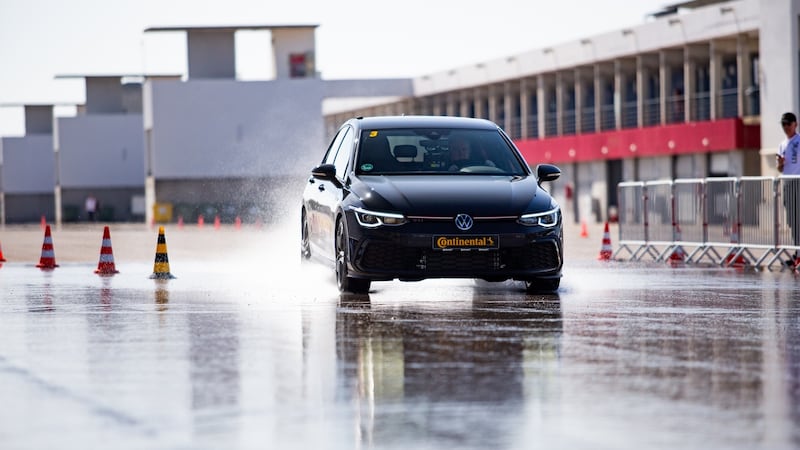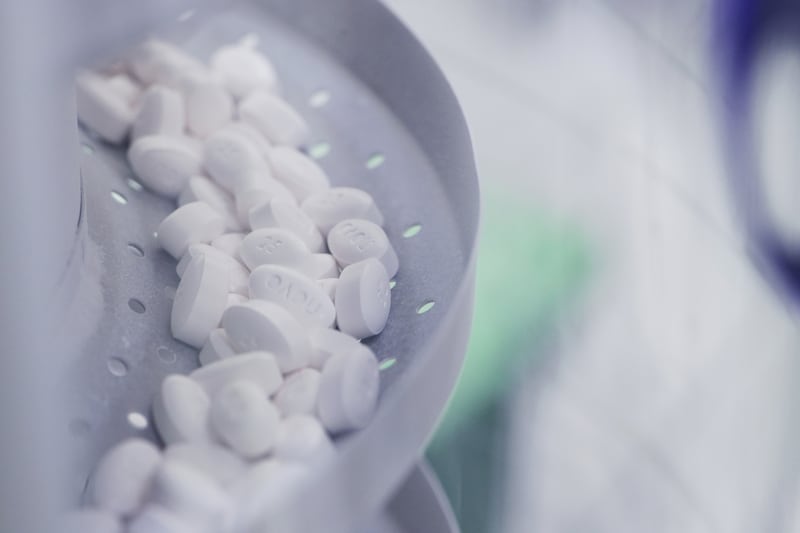It’s the sudden compression that gets you. That rollercoaster feeling as you hit the top of the crest, hang for a fraction of a second, before plunging down a precipitous slope, the ground filling your available vision.
On an actual rollercoaster, this is where you wave your hands in the air and shriek. I've got to keep my hands firmly on the steering wheel, or the Porsche I'm driving will happily fling itself into the scenery. Shrieking is optional.
The life of a tyre tester seems kind of fun, at least from this angle. I am at the Portimao track in Portugal sitting behind the three-spoke steering wheel of a bright yellow Porsche 911 Carrera 4S, and the three-litre turbocharged flat-six engine is screaming at the top of third gear as we plummet down the slope approaching turn 12.
The ground just falls away from under the car, gravity and longevity daring you to keep your foot pinned, clipping the apex before spearing back uphill, suddenly shoved back into your seat by the sudden return of centrifugal force, howling through the left-hand part of the corner.

After that, it’s time for a dose of brave pills, to see how long you can keep the car on full throttle before braking hard, really hard, for the tight hairpin-left of turn 13.
It’s thrilling. It’s visceral. It’s exhausting. The constant changes of g-force and the need to keep your eyes and head swivelling from braking point to turn in point to exit leave me drained and sweaty. And I’ve only done three laps.
I doubt Martin Shuppa ever gets sweaty. Tall, slim and softly spoken, he holds the tantalising title of Subjective Tyre Engineer. Once the lab-based boffins have run through their calculations and created a new tyre, it's Shuppa's job to take it out on the test track and see how it feels, as opposed to what the computer says it should feel like.
Mind you, Shuppa’s mind is probably running on pure binary code, so precise is he in his answers. What’s the first thing he does with a new tyre, I ask?
“The first thing I do is warm it up,” he says with a faint smile visible at the edges of the inevitable Covid mask. Then he gets serious.
“The first tests are those that test for comfort, and then we move on to things such as centre response – where you steer, then let go of the wheel and see how the tyre helps the car to correct itself. Then you change to the handling track and you start to test the behaviour of the tyre at the limits of grip, things like cornering behaviour, cornering stability, and load change.”
And then?
“And then I drive back to the workshop and change the tyres.” The wry smile, again.
You probably don’t think about your tyres much, mostly because no-one does. They’re round, black, and always seem to cost slightly more than you want to spend at any given time. When did any one of us last actually check our tyre pressures? Or tread depth? Most of us probably only change when the guy at the NCT centre points out that there’s canvas poking through.
Most motoring experts (and especially those involved in the actual business of selling tyres) regularly go blue in the face trying to remind people to test, check, and to buy the best tyres they can. While there’s an obvious commercial imperative in the tyre companies encouraging that, there are also genuine safety and performance benefits.
Put it this way, many of us will try to save €20 on the purchase of new tyres, buying them from a brand we’ve never heard of and can’t spell. We’ll happily spend thousands on a car because we like the badge, but then won’t bother shelling out for the only thing that actually connects said car to the road, and keeps it on that road when we need it to.

What's the difference, you might ask? Quite a lot, actually. Let's take a glance at wet-weather braking. Continental had soaked a stretch of tarmac in one corner of the Portimao track, and given us a pair of VW Golf GTIs to try on it.
One Golf wore last year’s SportContact6 tyres, the other the new SportContact7s. Over a series of braking manoeuvres, all from 80km/h to 0km/h, recorded by a clever data-logging device, we were able to come to a complete halt, on average, about 1.5m sooner on the new tyres than on the old ones.
Continental quotes an 8 per cent improvement in wet-weather braking, which doesn’t sound like much, but 1.5m is the difference between stopping just short of the car in front, and piling into its boot. And that, let’s remind you, is the difference between one Continental tyre and another. Imagine the difference between it and the random brand you’ve never heard of.
So the SportContact7 is a high-performance tyre which is why we were using a high-powered Porsche to stretch it to its limits. The process of creating it is the same, though.
Shuppa tells me that “okay, this SportContact7 is a performance tyre so we test it on the race track as well, but the basic procedure is the same whether it’s an economy tyre or a comfort tyre. We might focus a little more on outright performance with this tyre, and maybe are a little more focused on safety with, say, a PremiumContact tyre, but the basics remain the same”.
The same, it's worth pointing out, is true also of the other big-name brands; Michelin, Goodyear, Dunlop, Bridgestone, Pirelli and so on.
The basics, but not the detail. The compound (the mixture of rubber and synthetics that the tyre is made from) of this new SportContact7 is so sticky that Continental had to develop entirely new production processes to make it, mostly because the tyres kept sticking to the moulds used to make them.
Putting a hand on the tyre after a lap of Portimao, it’s so sticky it’s like touching lightly chewed toffee, yet according to the engineers, the mileage you can get from the tyre is actually 17 per cent better than before, because the stiff underlying construction helps so much.
There’s more; there are elliptical gullies at the sides of the tyre that keep squirting water out sideways even under hefty cornering loads, delaying the onset of aquaplaning.
There's also a bespoke nature to the tyre. Continental recognised that a high-performance tyre has to run the gamut from light sports cars and hot-hatchbacks all the way up to massive V8-engined SUVs and heavy, fast electric cars from the likes of Tesla and Audi. EVs, with their hefty kerb weight and instant-on torque, can actually benefit from a high-performance tyre.
Indeed, Continental was able to show off the breadth of the new tyre's ability, displaying it fitted to a Tesla Model Y electric SUV (with a modified bodykit and interior by Startech), and on the other side of the garage a highly-tuned, turbo-converted Lamborghini Huracan, which is packing 1,200hp and has a verified top speed of 385km/h.
So instead of compromising one to fit the other, the German company is actually turning one tyre into many; tweaking the construction and design of the SportContact7 depending on the rim size and the weight of the intended car. Continental claims to be the first tyre company to introduce that tailor-made process not just for cars fresh from the factory, but for the replacement market too.
The SportContact7 will also be something of a more democratic performance tyre than its predecessor. The SportContact6 was only ever available in pricey 19-inch rim size and above, but the new tyre will come in 18-inch form, and so will fit many more cars, right down to humble family-friendly stuff.
Later in the day, we’re back on the race track, this time in a pair of Hyundai i30N hot-hatches, with their 280hp turbo engines. Very different from the Porsche, but still blisteringly fast on the up-hill, down-dale lap of Portimao. On one lap, in an I30N fitted with the older SportContact6 tyre, I notice the car fidgets and shimmies under hard braking approaching one of corners.
The next time around, in the sister car running on the new SportContact7s, the shimmy is all-but gone, the car tracking straighter and truer, and keeping tighter to the apex when I turn into the corner. These are differences of small percentage, it’s true, and we’re really just mucking about on the track, while the Continental guys show me the ropes.
Here’s the thing, though. Tiny percentages magnify in the real world, when the chips are down, when it’s raining and the road is unfamiliar, and the corner suddenly tightens when you weren’t expecting it. Which tyres do you want on your car when that happens?



















